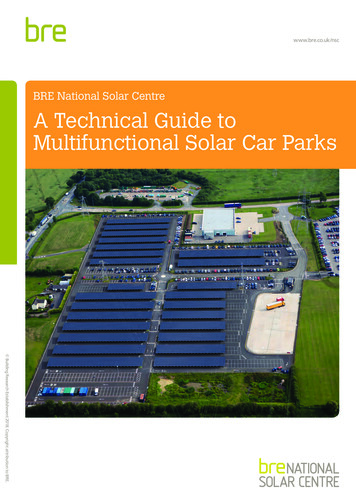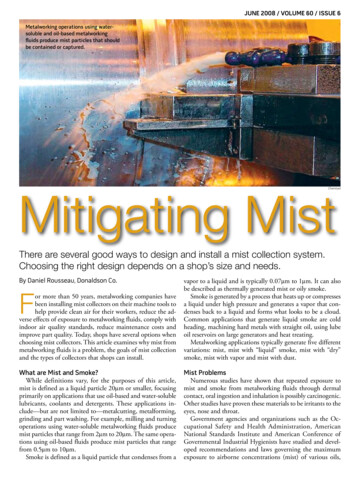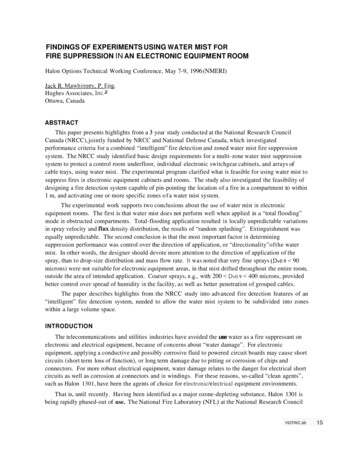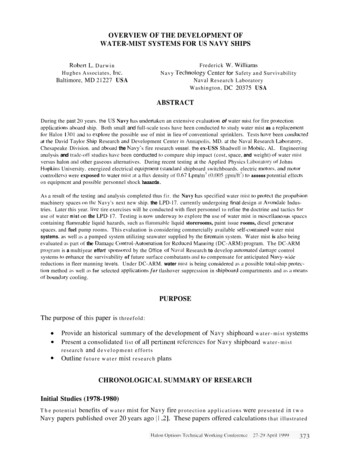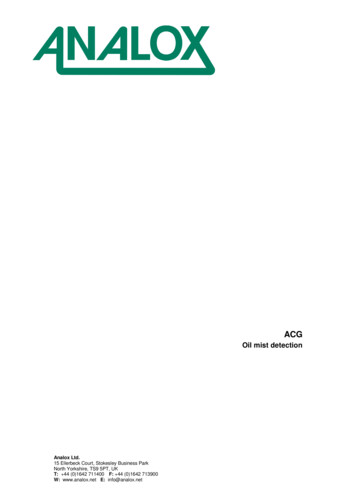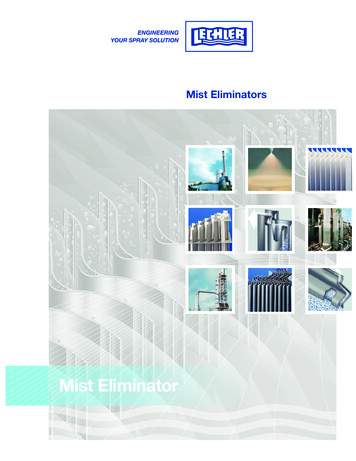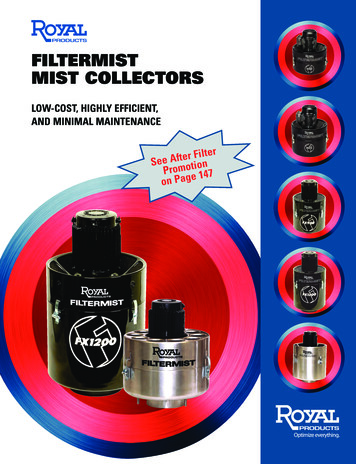
Transcription
An independent guide on water mist systems for residentialbuildingsPrepared byDr Corinne Williams and Dr Louise Jackman, Principal Consultants, BRE(version 2)The authors of this report are employed by BRE. The work reportedherein was carried out under a Contract placed by the DCLG. Any viewsexpressed are not necessarily those of the DCLG. Building Research Establishment 20061
troductionBackgroundTerms usedDescription of water mist systems4.1Overview4.2Design criteria4.2.1 Fire control mechanisms4.2.2 Fire control objective4.2.3 Duration of water mist protection4.3Protection of means of escape and fire-fighting access4.4Key componentsDescription of building types and fire hazards5.1Building types5.2Typical hazards and fire scenariosAssessment of water mist systems6.1Recommended questions for water mist systems contractors6.2Checklist and pro-forma for a water mist system assessmentEvidence of suitability of water mist system7.1Standards relating to water mist7.1.1 British standards7.1.2 European standards7.1.3 International standards7.1.4 USA standards7.1.5 International Maritime standards7.1.6 Approval standards7.1.7 Summary table of standards and relevance7.2Other technical evidence7.2.1 Fire performance tests7.2.2 Case studiesSystem suppliesDesign, installation, commissioning and maintenance of water mist systems9.1Design and installation9.1.1 Documentation9.1.1.1 Plans and specifications9.1.1.2 Design manual9.1.1.3 System flow calculations9.1.2 Information9.1.2.1 Background9.1.2.2 Building9.1.2.3 Fire hazards9.1.2.4 Details of water mist system design and components9.2Commissioning and maintenanceAlternative systems10.1Automatic sprinkler systemsReferencesAppendix A Checklist and pro-forma for a water mist system assessment Building Research Establishment 20062
AcknowledgementsSecretary of by the First Secretary of State. Any views expressed are notThe authors of this guide are employed by BRE. The work reported herein was carried outunder a contract placed by the then ODPM*. Any views expressed are not necessarily thoseof the Department.In addition, an industry Steering Group informed, reviewed and commented on the guide, andprovided relevant data/information. The individual Steering Group members that participatedand the organisations they represent are as follows.Steering Group memberOrganisation representedWilliams, CorinneJackman, LouiseAckland, RayAdie, HughBason, NickBond, AllanBowe, PhilipBurd, AnthonyClark, TonyCloke, AndyCranswick, EricCull, TraceyDaws, StevenGough, IanChairman and Co-ordinator, BRE Fire and SecurityBRE Fire and SecurityMarioffScottish Building Standards AgencyAssociation of British InsurersWelsh Assembly GovernmentFire Brigades UnionBuildings Division, DCLGAssociation of Consultant Approved InspectorsChief Fire Officers AssociationAqua-Mist Fire Technology LtdBuildings Division, DCLGThe Institution of Fire EngineersBritish Automatic Fire Sprinkler Association andAssociation of Building EngineersChief Fire Officers AssociationWormald (Ansul) UK LtdBuro HappoldAEAT (Research management contractor for DCLG)British Fire Protection Systems AssociationNational House-Building CouncilBritish Fire Protection Systems AssociationFire Sprinkler AssociationHardy, PaulHeaviside, LeslieMartin, StuartPayne, MikeRobert ThilthorpeTucker, MikeWells, DavidYoung, RoyThe authors would also like to thank fire safety officers from Merseyside Fire and RescueService and building control officers from Halton Borough Council who were interviewed andprovided valuable initial feedback on the water mist pro-forma and checklist.*Following machinery of government changes on 5 May 2006 ODPM became the Department ofCommunities and Local Government (DCLG) Building Research Establishment 20063
1.IntroductionThis is a guide to water mist systems primarily intended for use by approving authorities, e.g.building control bodies and fire safety officers, to detail current knowledge, improve educationabout systems, to dispel myths/misunderstandings and to assist them in assessing water mistsystems in residential buildings that they may be faced with.This guide also includes recommendations, cautions and commentary relating to the use ofwater mist systems for life safety in residential building applications and suggests when it maybe appropriate to obtain specialist advice.This guide applies to the majority of building types covered by Approved Document B6 (Firesafety) Residential purpose groups, group 1 and the sleeping areas of group 2.A water mist system is a fixed fire protection system, comprising components for automaticdetection and actuation, water supply delivery and water atomisation. A water mist systemdischarges a spray of small water droplets.Water mist systems are currently the subject of debate information about the overalleffectiveness of these systems for residential life safety applications is not well established.Water mist systems have been demonstrated to be suitable and effective for the protection ofspaces on board ships and are an emerging technology for life safety building applications onland. They have successfully been applied to protect assets, e.g. electronic equipment,machinery spaces and deep fat fryers in buildings and now are being increasingly consideredfor a range of building applications, e.g. for residential premises.Assessment of water mist systems requires case by case review. This guide contains anassessment checklist and pro-forma to assist building control professionals and fire safetyofficers in coming to a judgement on the suitability of a particular water mist system for lifesafety purposes in specific residential building applications.Although this guide is focused on life safety applications, information and principles containedin it may also be appropriate for water mist systems installed for property/asset protection.However, it is recommended that insurers should be consulted for property/asset protectionapplications.This guide is not a regulatory document. It does not specifically cover water mist systems foruse in non building applications, non residential types of buildings, e.g. commercial andindustrial, object protection water mist systems or portable water mist systems. Building Research Establishment 20064
Background2.This section includes a brief historical context and the current emerging water mist scene inthe UK, the reasons for considering these systems, how water mist systems fit in with otherfire protection measures and cost considerations.A form of water mist system was originally used in the 1930s in industrial applications forasset protection. In the last decade, water mist came to prominence for fire protection use onboard ships and for industrial and commercial applications. In the last ten years, water misthas been the subject of extensive research and development, resulting in systems that havebeen optimised and proven for some applications, e.g. machinery spaces. Currently, watermist systems are an emerging technology for life safety building applications, includingresidential buildings.In 2004, BRE carried out a survey on behalf of DCLG on water mist, fog and similar systemsused in buildings1. The survey found that there were over 1000 water mist systems installedin buildings in the UK. Most of the water mist systems installed in life safety applications hadbeen provided in the last two or three years. The building control professionals and fire safetyofficers reported high numbers of systems installed in dwellinghouses and flats andmaisonettes. Many of the water mist systems had been installed as a compensatory featureto meet provisions of the Building Regulations and on fire and rescue servicerecommendation.The main concern and challenge for a building control professional or fire safety officer, whenconsidering the approval of a water mist system for a life safety residential application, is thatthe information available is limited.The approval process would normally rely on the application of appropriate system standards.However, in the case of water mist systems, there are currently no published British orEuropean standards for components or systems. A European Technical Specification is inpreparation, but this does not currently include residential applications. Other existing watermist standards, e.g. USA and marine, are not directly applicable to UK building applications.Therefore, expert interpretation and further work is required.However, the sources of further information on which to base expert interpretation are limited.Issues relating to the equivalence of performance of water mist systems compared to otheractive and passive fire protection measures have not been investigated. Aspects such asreliability, real fires history and long-term maintenance are largely unknown or unproven.The potential reasons for considering water mist systems include: Life safety benefit additional to the current provisions of the Building RegulationsLife safety compensatory feature to meet current provisions of the BuildingRegulationsFire service recommendationProperty/asset protectionAlternative to an automatic sprinkler system (life safety/property/asset protection).Examples of circumstances where water mist systems have been applied are: Where there is a risk of life lossWhere there is a high incidence of fires occurring or where vulnerable occupants arehoused Building Research Establishment 20065
Where extended travel distances or reduced fire separation requirements are soughtWhere fire and rescue service access to the building and facilities may be restrictedWhere there are high value items or historic features requiring protection.If a water mist system is being proposed as a compensatory feature to meet provisions of theBuilding Regulations or other Regulatory requirements, it is critical that all aspects of thisguide are considered. Approving authorities should carry out a thorough assessment of thewater mist system to confirm that it is appropriate and acceptable as for any compensatoryfeature.Water mist systems are part of the overall package of fire safety measures in a residentialbuilding and should not be considered in isolation. For example, there would generally besmoke alarms or a fire detection and alarm system installed and passive fire protectionmeasures in place.Consideration of the costs of a water mist system for residential premises does not simplyinclude the costs of installation and provision of water supplies, but also includes the costs forannual inspection, testing and ongoing system maintenance.If a water mist system is being proposed as a compensatory feature, there may be indirectcost reductions due to building design changes.There are other building life safety applications for water mist systems, which include: office,shop and commercial, assembly and recreation, industrial and storage. Although this guide isfocused on residential premises, the methodology laid out in this guide may be appropriate forthese applications. However, the specific water mist systems details will differ for eachapplication, such as: Reasons for considering the systemFire hazardsBuilding types and featuresSystem typeSystem design, installation and maintenanceFire performance tests. Building Research Establishment 20066
3.Terms usedRelated to Q1 in checklist in Appendix A: Is this a water mist system?The common terms used in this guide and their meanings are as follows.Approving authorities. Examples of approving authorities are: Building control bodies, firesafety officers, environmental health officers, registered social landlordsDeluge system is a system in which, when the control valve is opened, water flows into thepipework and discharges simultaneously through all the nozzles attached to the systemDry pipe system is a system in which the pipework is charged with air or inert gas underpressureHigh pressure water mist system is a system in which the system pressure is greater thanor equal to 35 barLight hazard sprinkler system is an automatic sprinkler system designed, installed andmaintained to British Standard BS 5306 or European Standard EN 12845 for a light hazardoccupancy, i.e. occupancies with low fire loads and low combustibility, with no singlecompartment greater than 126 m2, with a fire resistance of at least 30 minutes. (Not coveredin this guide)Low pressure water mist system is a system in which the system pressure is less than orequal to 12.5 barMedium pressure water mist system is a system in which the system pressure is between12.5 and 35 barObject protection system (also known as local application system) is a water mist systemdesigned to discharge water mist directly onto an object or hazard. These systems havebeen installed to protect inside enclosures, unenclosed objects within buildings and outdoorapplications. A typical example would be a gas turbine. (Not covered in this guide)Pre-action system is a dry system in which the control valve can be opened by anindependent fire detection system in the protected area, prior to the independent operation ofany automatic nozzleResidential sprinkler system is an automatic sprinkler system for domestic and residentialpremises, designed, installed and maintained to British Standard BS 9251. (Not covered inthis guide)Water application rate is the water flow rate, in litres/minuteWater fog is another name sometimes used to describe the sub category of high pressurewater mist systemsWater mist system provides a water spray for which 90% of the flow-weighted cumulativevolumetric distribution of water droplets is less than 1000 microns. This value is found at the2minimum design operating pressure and is measured in a plane 1 m from the nozzleWater mist system contractor is a contractor who is appropriately assessed, qualified andexperienced to carry out design, installation and maintenance of water mist systems Building Research Establishment 20067
Water spray system is similar, in principle, to a sprinkler system, designed to extinguishflammable liquid fires, or to provide cooling to an exposed area likely to be subjected tointense heat radiation from a neighbouring fire, widely used in the process industry. (Notcovered in this guide)Wet pipe system is a system in which the pipework is always charged with waterVolume protection system is a system designed to discharge water mist to protect allhazards in a predefined volume, usually a room. A typical example would be rooms in adwelling Building Research Establishment 20068
Description of water mist systems4.Related to Q1 in checklist in Appendix A: Is this a water mist system?Related to Q10 and Q10a in checklist in Appendix A: What are the designassumptions? Are the design assumptions acceptable?Related to Q11, Q11a and Q11b in checklist in Appendix A: Has the relevantdocumentation been provided? Does the documentation contain all the relevantinformation? Is the system design, installation and maintenance acceptable?Related to Q12 and Q12a in checklist in Appendix A: Have all the system componentsbeen assessed? Are all the system components acceptable?Related to Q13 in checklist in Appendix A: Are the proposed system detailsacceptable?Overview4.1A water mist system is a fixed fire protection system that uses water to control, suppress orextinguish a fire. The system comprises automatic nozzles attached to a piping systemcontaining water and connected to a water supply. At operation, the water mist systemdischarges a cone of spray containing small water droplets that fills the protected zone withwater mist. Some systems additionally discharge other gases or include additives. Aneffective water mist system should generate, distribute, and maintain a concentration of smalldroplets sufficient for the protection of the fire risk for sufficient time to meet the objective ofthe protection. Fundamental to achieving this is: Maintaining the correct pressure/flow characteristics at the nozzle for sufficient time Careful placement of the nozzles to ensure full coverage of the space and minimalwater wastage due to collisions of the spray with solid surfaces (beams, walls,cupboards)Also, it may be important to shut down air flows, e.g. from ventilation systems, to minimisewater mist loss from the protected volume.4.2Design criteriaThe system contractor should detail the criteria upon which the water mist system design isbased. These include: Fire control mechanismsFire control objectiveDuration of water mist protection. Building Research Establishment 20069
4.2.1Fire control mechanismsIn the event of a fire, a heat sensitive quick response glass bulb is generally used to actuatethe water mist system. Therefore, at the time of actuation in a residential premise, the fire islikely to be well established and appropriate for water mist control. In some cases, otherforms of detectors are employed.Following actuation, the water droplets discharged from a water mist system penetrate thefire. The intention is to reduce the temperature, the radiative heat and the oxygenconcentration in the zone where the fire and water mist interact. The remainder of the room isprotected by cooling of the hot fire gases and smoke, and some wetting of other potentialcombustible fuels in the room.Because water mist does not primarily extinguish by direct wetting of solid fuels, its impact on,for example, deep-seated fires will be slow. Other scenarios where water mist may not beable to extinguish fires include: small fires and shielded fires.4.2.2Fire control objectiveThe design fire control objective for a water mist system can be: Fire extinguishment. A sharp reduction in heat release rate leading to completeelimination of any flaming or smouldering fire or Fire suppression/control. A steady reduction in the heat release rate resulting in alower controlled level of burning/limitation of fire growth and protection of structure (bycooling of the objects, fire gases and/or by pre-wetting adjacent combustibles).The fire control design objective for a water mist system needs to be clearly stated by thewater mist contractor with supporting evidence, so that an approving authority can makejudgements about the fire risk assessment and interactions with other fire protection systemsfor the residential premises.4.2.3Duration of water mist protectionAn appropriate minimum duration of water supply needs to be selected for each project as itis currently not a prescribed standardised value. Values of minimum duration of water supplycould be taken as for automatic sprinkler systems, for similar premises, e.g. minimumdurations for:5Domestic -in excess of 10 minutes for BS 9251 sprinkler systemsResidential -30 minutes for BS 92515 sprinkler systemsor in excess of 60 minutes for BS EN 128453 or BS 5306 Part 24 sprinklersystems.The system contractor should detail the minimum duration of protection with supportingevidence.People in sleeping areas can be categorised as at a higher risk from fire as they may: Need to be woken up Be disorientated Be aged or infirm Building Research Establishment 200610
Be under the influence of drugs or alcohol Need assistance to escape.In institutional residential buildings, there may be only a few staff available to assist people toescape at night. Therefore, it may be important to extend the duration of water mistprotection.Premises which are occupied by people requiring assisted escape may need specialconsideration e.g. provision of a longer duration of water mist protection, provision ofdetectors with greater sensitivity and development of an appropriate management strategy.4.3Protection of means of escape and fire-fighting accessAspects that need to be considered and addressed by the system contractor (see sections 7and 9), in particular for water mist systems that are being installed as a compensatory featureto meet the Building Regulations requirements, are: Extent of fire suppression/control Tenability of conditions inside premises Time required for safe escape of occupants Time required for safe fire-fighter access Likely scenario after the water mist has finished discharging.Questions that need to be considered by building control professionals, include: Will the conditions in the room of fire origin remain tenable for a specified period oftime? Will the conditions in adjacent rooms and escape routes remain tenable for asufficient time for occupants to escape safely to a place of safety? Will there be sufficient time for fire and rescue service personnel to enter thepremises safely to effect firefighting (and rescue) activities?For water mist project design solutions, there will be assumptions about interactions with fireand rescue service activities. For example, water mist systems may allow conditions in theroom of origin to remain tenable for a specified period of time, and fire and rescue servicepersonnel may be expected to enter the room to extinguish the fire.Therefore, early consultation with the fire and rescue service is strongly recommended.Key components4.4Commercially-available water mist systems are all distinctly different. They are notstandardised or of pre-described forms, unlike automatic sprinkler systems. However, theycan be categorised by reference to the following key components: Fire fighting medium - potable water, water with antifreeze, water with additive, waterwith inert gas Building Research Establishment 200611
Detection – automatic quick response glass bulb nozzles, smoke detectors andactuators, with or without cover plates, alarms and control panel and alarm system Atomisation – nozzle and orifice, filters and strainers, single fluid system, twin fluidsystem, low pressure ( 12.5 bar); medium pressure ( 12.5 bar and 35 bar), highpressure: ( 35 bar) Delivery - wet pipe system, dry pipe system, pre-action system, deluge system, pipe(material e.g. stainless steel, fire rated CPVC plastic †, copper, supports) Supply – storage vessel (e.g. tanks, cylinders), towns mains, propellant (e.g.nitrogen), pumps.Most water mist systems for use in residential buildings will be low pressure, wet pipesystems, with automatic, quick response glass bulb nozzles, supplied by cylinders or tankscontaining potable water.†Chlorinated Polyvinylchloride Building Research Establishment 200612
An example layout of a water mist system in a dwellinghouse, showing pressurised watercylinders and optional mains water supplies, is shown in Figure 1.Figure 1 An example layout of a water mist system in a dwellinghouse showingpressurised water cylinders and optional mains water supplies Building Research Establishment 200613
An example layout of a water mist system in a residential premises showing a pump and tankarrangement is shown in Figure 2.Figure 2 An example layout of a water mist system in a residential premises showing apump and tank arrangementFigures 1 and 2 are indicative schematic diagrams and show some of the key components.They do not represent actual systems. For example, an actual system may have additional oralternative components and/or water supplies with additives.For further information regarding components and system design, see section 9. Building Research Establishment 200614
Description of building types and fire hazards5.Related to Q2 in checklist in Appendix A: What is the main purpose of this water mistsystem?Related to Q3 in checklist in Appendix A: Is this proposed water mist system beinginstalled in residential building types covered by this guide?Related to Q4 in checklist in Appendix A: What areas are protected?Building types5.1This guide is primarily concerned with the majority of building types covered by ApprovedDocument B6 purpose groups 1 and 2 - Residential. Approved Document B is the fire safetyguidance document that supports Part B (Fire safety) of the Building Regulations. Definitionsof purpose groups can be found in Appendix D of Approved Document B. These have beensummarised as follows: Flat or maisonette 1(a)Dwellinghouse 1(b and c)Residential homes for elderly people (2a)Residential home for disabled people (2a)Residential home for children (2a)Boarding school (2a)Nursery (2a)Place of lawful detention (2a)Hotel (2b) - residential areasBoarding house (2b)Residential college (2b)Hall of residence (2b)Hostel (2b).This guide only applies to the sleeping areas in purpose group 2 of Approved Document B6,e.g. bedrooms, corridors, hotel suites and associated rooms. This guide does not apply toother areas in these buildings, e.g. restaurants, places of assembly and storage areas.Special considerations apply to places of lawful detention.5, 7In UK residential sprinkler standards the categories of domestic and residentialoccupancies are described. These categories are covered by this guide, as follows.Domestic occupancy is an individual dwelling for occupation as a single family unit, e.g.individual dwellinghouses, individual flats, maisonettes and transportable homes, with amaximum individual room size of 40 m2.Residential occupancy is a building for multiple occupation not exceeding 20 m in height, witha maximum individual room size of 180 m2, e.g. residential homes, Houses of MultipleOccupancy (HMO), blocks of flats, boarding houses, aged persons homes, nursing homes,residential rehabilitation accommodation and dormitories. Building Research Establishment 200615
5.2Typical hazards and fire scenariosRelated to Q4a in checklist in Appendix A: Are there any special hazards?This section considers typical hazards and fire scenarios inside those buildings in which watermist systems might be expected to perform.In residential premises, there are many sources of heat and many things that could burn.Sources of heat include: cigarettes, matches, candles, cooking appliances, heaters, electricalor mechanical appliances, faulty wiring.Potential fuels include: wooden, plastic or upholstered furniture (beds, cupboards, tables,sofas, chairs), furnishings (curtains, bedding), and other items (televisions, clothing, videos,compact discs, newspapers, books, magazines, computers, plastic storage containers).Some examples of fire scenarios are: A cooking accident in a kitchen (chip pan of oil catching fire, leaving something tooclose, in or on the cooker, forgetting to turn cooker off, leaving something in the grill)resulting in a fire which could spread to curtains or cupboards. Ignited candle too close to a television setting the television alight, which couldspread to curtains and furniture in a lounge. Matches or smokers’ materials thrown away into a waste paper bin causing a wastebin fire which spreads to furniture in a bedroom or lounge. A faulty electrical item placed close to furniture, fabrics or papers, causing a firewhich then spreads. Overloaded plugs or faulty circuit breakers setting appliance and curtains alight whichthen spreads to other furniture. Matches or smokers’ materials setting bedding alight, which spreads to the bed itselfand other furniture and fabrics in a bedroom.It is recommended that any special hazards, e.g. high fire loadings, are considered.If there is any change of use of the building in the future, the assessment of hazards needs tobe reviewed. Building Research Establishment 200616
Assessment of water mist systems6.This is the key part of the guide.Recommended questions for water mist systems contractors6.1The following are recommended questions that approving authorities could ask of water mistsystems contractors to assist building control professionals and fire safety officers to come toa judgement on the suitability of a water mist system use for specific residential buildingapplications.Project description: Is this a water mist system? (see section 3 of this guide) What is the main purpose of this water mist system? (see sections 2 and 5 of thisguide) Is this proposed water mist system being installed in residential building typescovered by this guide? (see section 5 of this guide) What areas are protected? (see sections 5 and 9 of this guide). Are there any special hazards? (see section 5.2 of this guide).Assessment of system performance: Is the proposed system performance acceptable? (see section 7 of this guide) What standards have been used for the system design, installation and components?Is this/are these appropriate standard(s)? (see section 7.1 of this guide) What other evidence has been presented? Is this appropriate technical evidence?(see sections 7.2 and 7.2.2 of this guide)oWhat fire tests have been undertaken? Is the fire testing applicable to the realbuilding scenario? What fire test details have been provided? Is the firetesting appropriate and sufficient? (see sections 7.1 and 7.2.1 of this guide)oHas any other evidence of suitability of water mist system been supplied?(see sections 7.2 and 7.2.2 of this guide)Assessment of system details: What are the design assumptions? Are they acceptable? (see section 4 of this guide) Has all the relevant documentation been provided? Does the documentation containall the relevant information? (see sections 4 and 9 of this guide and section 8 forwater supplies) Is the system design, installation and maintenance acceptable? (see section 9 of thisguide) Have all the system components been assessed? Are all the system componentsacceptable? (see sections 4, 7.1 and 9 of this guide) Building Research Establishment 200617
6.2Are the proposed system details acceptable? (see sections 4, 7, 8 and 9 of thisguide)Checklist and pro-forma for a water mist system assessmentAppendix A contains an assessment checklist and pro-forma to assist approving authorities tocome to a judgement on the suitability of a water mist system for specific residential buildingapplications. Building Research Establishment 200618
Evidence of suitability of water mist system7.Related to Q9 in checklist in Appen
A water mist system is a fixed fire protection system, comprising components for automatic detection and actuation, water supply delivery and water atomisation. A water mist system discharges a spray of small water droplets. Water mist systems are currently the subject of debate information about the overall
